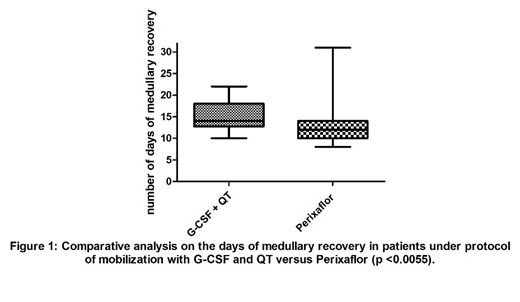INTRODUCTION: Peripheral Hematopoietic Stem Cells have been widely used as a source for Autologous Hematopoietic Stem Cell Transplantation (HSCT). The use of G-CSF associated with chemotherapy increases the number of circulating Hematopoietic Progenitor Cells; however, there is no harmony about the best medical strategy for the use of G-CSF associated with the mobilization conduct. The use of plerixafor for poorly mobilized patients has provided a safe and effective option for optimizing apheresis procedures despite the high cost. Thus, the evaluation of efficacy becomes essential for the incorporation of plerixafor into the HSCT routine. OBJECTIVE: To evaluate the mobilization of autologous HSCT in chemotherapy associated with G-CSF and cyclophosphamide (QT) versus plerixafor. METHODS: Retrospective evaluation of 66 patients mobilized for autologous HSCT with G-CSF associated with chemotherapy versus plerixafor (plerixafor was used in the first mobilization), also to evaluate the number of apheresis procedures, CD34-positive cells, cell viability and for the bone marrow engraftment date. Statistical analyses were performed with GraphPad Prism 5.0 (GraphPad Software, Inc., San Diego, CA), using the Mann-Whitney test for nonparametric data (p <0.05). RESULTS: A mobilization protocol was performed in 83 patients (60% male), with a median age of 55 years (17 to 68 years). Multiple myeloma (55.7%), Hodgkin's lymphoma (14.7%), Non-Hodgkin's lymphoma (16.39%), primary amyloidosis (4.9%) were the most common hematologic malignancies. There was no statistical difference between G-CSF and QT group versus plerixafor groups regarding age, sex, type of disease and previous QT. The plerixafor group had better CD34 positive cell counts compared to G-CSF and QT (median 6.2 versus 3.8 x106, p<0.004), shorter sessions of apheresis procedure (median 2 versus 4, p < 0.0002) and a better cell viability rate (98 versus 95%, p <0.0034). The bone marrow engraftment rate was 10 days for plerixafor group versus 15.05 days for G-CSF and QT group, p <0.0055 (Figure 1).CONCLUSION: Our results showed the mobilization group using plerixafor had superior data and statistical significance regarding the number of apheresis procedures, cell viability, number of CD34 positive stem cells and earlier bone marrow engraftment rates when compared to the G-CSF + QT. These findings suggest and encourage the use of plerixafor in the first mobilization, as well as it should be incorporated into the standard routine. In addition, the number of apheresis procedures will be reduced, cell viability and CD34-positive cells rate will be increased. As a result, there will be a better medullary recovery and the reducing of both hospital costs and infectious complication rates.
No relevant conflicts of interest to declare.
Author notes
Asterisk with author names denotes non-ASH members.


This feature is available to Subscribers Only
Sign In or Create an Account Close Modal